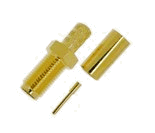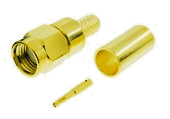Search
Important contacts
Technical
support
support
How to Recognize Reverse Connector?
5/8/2008
If you have no sure answer, or if you had found yourself in the situation in the past of returning wrong components to the supplier, please read the following article.
At a first glance, it could seem absurd to write about something as common as the connector with reverse polarity (RP) is. You could say, "Anybody must recognize such connector!" Unfortunately practical world shows that even the experienced technician can make a mistake because of the unclear and incorrect marking of the connector and because of the "well-meant" advises. The following paragraphs describe the most common errors of the reverse polarity and its issues.
Habitual Error
The most common error of the customers is related to the design of the connector. The erogenous fallacy here is to think of the reverse polarity as of the connector being either "male" or "female"; thus, if the connector is of the reverse polarity, the customer immediately assumes the connector has changed from the "male" to the "female" type. This in not true! The reverse polarity has to do with the change of the internal contact of the connector while preserving its design.
Standard Connector Design
The connectors are usually used in pairs, meaning we need the "male" and the "female" type. The "female" connector is sometimes referred to as "Jack". Such connector has the external thread and the internal "socket" contact. The "male" type is screwed onto this passive-type connector. The "male" type is equipped with the internal thread and the internal "pin" contact. The "male" connector is sometimes referred to as "Plug".
The picture below shows the SMA Plug (left) and the SMA Jack (right).

Reverse Polarity Connector Design
The connector with reverse polarity (RP) has the following design:
- RP "Plug" looks the same as the standard connector but it has the "female-type" internal "socket" contact.
- RP "Jack" looks the same as the standard connector but it has the "male-type" internal "pin" contact.
The picture below shows the Reverse SMA Plug (left) and the Reverse SMA Jack (right).

With regard to their parameters, the reverse polarity connectors are not any different from the standard connectors and they all conform to the FCC Standards (Federal Communications Commission Standards).
Applications
For what purposes are the reverse polarity connectors used when they have the same parameters? They are used for safety purposes. The manufacturers want to be sure the correct (authorized) antennas will be connected to their devices. If you connect the antenna with Standard Plug Connector to the access point with Reverse Jack Connector, the connection will not be functional.
Different manufacturers use different Reverse Polarity Connectors. For the summary, we show some examples below:
- Signamax uses Reverse SMA Connectors
- Cisco uses Reverse TNC Connectors
- Symbol uses Reverse BNC Connectors
Exception to the Rule
The SMB Connectors are the only exception to the rule. They feature the Standard Plug with Socket and the Standard Jack with Pin.
Habitual Error
The most common error of the customers is related to the design of the connector. The erogenous fallacy here is to think of the reverse polarity as of the connector being either "male" or "female"; thus, if the connector is of the reverse polarity, the customer immediately assumes the connector has changed from the "male" to the "female" type. This in not true! The reverse polarity has to do with the change of the internal contact of the connector while preserving its design.
Standard Connector Design
The connectors are usually used in pairs, meaning we need the "male" and the "female" type. The "female" connector is sometimes referred to as "Jack". Such connector has the external thread and the internal "socket" contact. The "male" type is screwed onto this passive-type connector. The "male" type is equipped with the internal thread and the internal "pin" contact. The "male" connector is sometimes referred to as "Plug".
The picture below shows the SMA Plug (left) and the SMA Jack (right).
Reverse Polarity Connector Design
The connector with reverse polarity (RP) has the following design:
- RP "Plug" looks the same as the standard connector but it has the "female-type" internal "socket" contact.
- RP "Jack" looks the same as the standard connector but it has the "male-type" internal "pin" contact.
The picture below shows the Reverse SMA Plug (left) and the Reverse SMA Jack (right).
With regard to their parameters, the reverse polarity connectors are not any different from the standard connectors and they all conform to the FCC Standards (Federal Communications Commission Standards).
Applications
For what purposes are the reverse polarity connectors used when they have the same parameters? They are used for safety purposes. The manufacturers want to be sure the correct (authorized) antennas will be connected to their devices. If you connect the antenna with Standard Plug Connector to the access point with Reverse Jack Connector, the connection will not be functional.
Different manufacturers use different Reverse Polarity Connectors. For the summary, we show some examples below:
- Signamax uses Reverse SMA Connectors
- Cisco uses Reverse TNC Connectors
- Symbol uses Reverse BNC Connectors
Exception to the Rule
The SMB Connectors are the only exception to the rule. They feature the Standard Plug with Socket and the Standard Jack with Pin.
Login
If not specified prices are without VAT in EUR.

